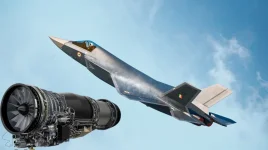- Views: 3K
- Replies: 11
In a major stride towards bolstering its strategic deterrent, India has officially confirmed the development of the Rudram-4, a state-of-the-art air-launched hypersonic missile.
The announcement, made by the Chief of the Defence Research and Development Organisation (DRDO), underscores a significant enhancement of the Indian Air Force's (IAF) long-range strike capabilities.
The Rudram-4 is designed to travel at hypersonic speeds—more than five times the speed of sound—and follow an unpredictable quasi-ballistic flight path.
This combination of extreme velocity and high maneuverability makes it exceptionally difficult for existing air defence systems to detect and intercept, ensuring a high probability of mission success.
A New Pinnacle in the Rudram Missile Family
The Rudram-4 is the latest and most advanced entry in the indigenously developed Rudram series of air-to-surface missiles. The series, whose name translates from Sanskrit as "Remover of Sorrows," is designed to neutralize critical enemy assets from a safe distance.The program includes several variants tailored for specific roles:
- Rudram-1: An anti-radiation missile designed to home in on and destroy enemy radar installations and communication hubs. With a range of up to 200 km, it has been successfully tested and is ready for production.
- Rudram-2: A hypersonic missile tested in May 2024, capable of both ground attack and anti-radiation missions with a range of 300 km.
- Rudram-3: A long-range weapon with a reach of 550 km, designed for deep penetration strikes against high-value, fortified targets.
Technical Capabilities of Rudram-4
According to the DRDO Chief, the Rudram-4 is being developed as a Long-Range Stand-Off Weapon (LRSOW). While its exact range is classified, it is expected to exceed the 300 km mark and potentially surpass the 550 km range of the Rudram-3.Key features of the Rudram-4 are set to include:
- Hypersonic Speed: The missile will achieve speeds greater than Mach 5 (approx. 6,174 km/h), drastically reducing flight time and giving adversaries minimal warning.
- Quasi-Ballistic Trajectory: Unlike conventional ballistic missiles that follow a predictable arc, the Rudram-4 can maneuver at low altitudes, flying under the radar coverage of most air defence systems, similar to Russia's Kinzhal missile.
- Lightweight Design: It is speculated to be lighter than earlier versions, a crucial factor that allows it to be integrated with a wider array of IAF aircraft, including the Sukhoi Su-30 MKI, Mirage 2000, and Dassault Rafale.
- Pinpoint Accuracy: The missile will be guided by a combination of Inertial Navigation System (INS) and GPS, along with advanced seekers like an Imaging Infrared (IIR) sensor for precise targeting of command centres, SAM batteries, and reinforced bunkers.
Strategic Implications for Regional Security
The development of Rudram-4 is a direct response to the evolving security landscape in the region.The missile is designed to provide India with a credible capability to carry out missions aimed at the Suppression of Enemy Air Defences (SEAD) and Destruction of Enemy Air Defences (DEAD). These operations are critical for clearing a path for friendly aircraft to operate safely within hostile airspace.
The Rudram-4's capabilities present a potent counter to advanced surface-to-air missile (SAM) systems, such as the HQ-9 and S-400 deployed in the region.
By enabling the IAF to strike targets deep within enemy territory without putting its pilots and aircraft at risk, the missile acts as a significant "force multiplier."
This advancement places India in a select group of nations, including the United States, Russia, and China, that are actively developing or have fielded hypersonic weapon technologies.
By pursuing self-reliance in this critical area, India aims to maintain strategic parity, deter potential aggression, and ensure its armed forces are equipped with next-generation technology to safeguard national interests.



